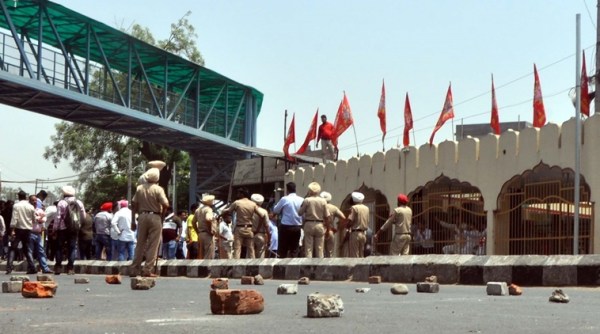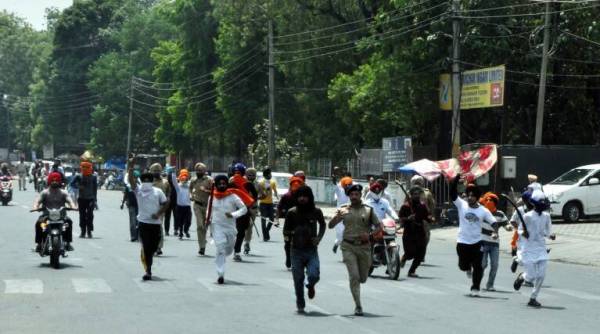Ahead of Patiala clash, a build-up on social media to counter Sena march

On Friday, members of Shiv Sena (Bal Thackeray) began a ‘Khalistan Murdabad March’ in Patiala while Sikh activists, including Nihangs, took out another march opposing that event. The two groups came face to face outside Kali Mata temple and hurled stones at each other. Police had to fire in air to disperse the mob.
While it is yet not clear who led the group that reached the spot outside the temple where the clash took place, a Sena leader had claimed that they had planned the march to counter the alleged announcement by the outlawed overseas group ‘Sikhs for Justice’ to mark the ‘foundation day of Khalistan’ on April 29.
The announcement by the SFJ, in fact, had pitted several Sikh bodies and social media influencers against each other.
A group of Sikh activists, who were present near Temple, when the clash took place, accused Baljinder Singh Parwana, a social media influencer, of giving the call for the protest against the Sena event but not turning up to after clash erupted. They said, while Parwana stayed back at the gurdwara, others marched towards the Shiv Sena faction members who were present at Kali Mata temple.
Punjab has in the recent past seen a rise in the number of Sikh bodies, activists and social media influencers coming together despite the lack of any common ideology. Experts attribute this phenomenon to the weakening of mainstream Sikh parties such as the Shiromani Akali Dal and its rival groups such as SAD (Amritsar), Dal Khalsa and others.
 Clashes erupted between Shiv Sena (Bal Thackeray) workers and Nihang Sikhs near Kali Mata Mandir in Patiala on Friday. (Express Photo By Harmeet Sodhi)
Clashes erupted between Shiv Sena (Bal Thackeray) workers and Nihang Sikhs near Kali Mata Mandir in Patiala on Friday. (Express Photo By Harmeet Sodhi)
SAD (Amritsar), the only political outfit in Punjab that still contests elections on the issue of Khalistan, claimed it was not involved in the clash. “We were protesting peacefully outside the mini secretariat. We were not involved in the clash,” said the party’s Patiala unit president, Harbhajan Singh Kashmiri.
The group protesting against the Sena march had no clear leader or established face. The first such surge of unorganised Sikh youth and small outfits was witnessed on June 6, 2014, during an event to mark the 30th anniversary of Operation Blue Star. Some unknown Sikh youths had then clashed with officials and staff of the Shiromani Gurdwara Parbandhak Committee (SGPC) inside the premises of the Golden Temple. Some of the arrested youths had no affiliation with any political outfit.
A year later, Punjab witnessed a complete shutdown for more than seven days following the death of two Sikh youth in police firing at Kotakpura during a protest against the alleged sacrilege incidents. Though there was no call for a shutdown by the established parties, it was spontaneously enforced by the youths.
 A view of the clash site in Patiala where bricks and stones lay scattered after the clashes. (Express Photo By Harmeet Sodhi)
A view of the clash site in Patiala where bricks and stones lay scattered after the clashes. (Express Photo By Harmeet Sodhi)
In 2016, several Sikh outfits gathered on a bridge on Beas river in Beas town to protest against a call given by a Shiv Sena faction to organise a ‘Lalkar Rally’ in Amritsar. The Sikh outfits had gathered following calls made on social media.
In the case of Patiala, Parwana was the first to take to Facebook to oppose the call of Shiv Sena leader Harish Singla. He also met police officials seeking a ban on the march planned by the Sena. Parwana, who was also linked to lynching of an unidentified person over allegations of sacrilege at a gurdwara in Kapurthala, also uploaded several videos and gave a call to the community to be ready for April 29 in case police fail to stop the Sena group from carrying out its march.
Apart from Parwana, some other fringe organisations too responded to the Sena call and decided to oppose their march. Since there was no clear leader, those opposed to the Sena march gathered at least three places in Patiala. While police was managing one group of protesters at Fountain Chowk, another group reached near Kali Mata temple where they clashed with the Sena members.
 Punjab has in the recent past seen a rise in the number of Sikh bodies, activists and social media influencers coming together despite the lack of any common ideology. (Express Photo By Harmeet Sodhi)
Punjab has in the recent past seen a rise in the number of Sikh bodies, activists and social media influencers coming together despite the lack of any common ideology. (Express Photo By Harmeet Sodhi)
A common thread connecting these disparate Sikh outfits is the idea of ‘Khalistan’, with most of them either supporting the idea or being sympathetic to it.
Mahant Ravi Kant, chairman of the Hindu Welfare Board, said, “Some people demand Khalistan, some demand Hindu Rashtra. Making these demands peacefully is their constitutional right. But nobody should be allowed to disturb the peace of state”.

